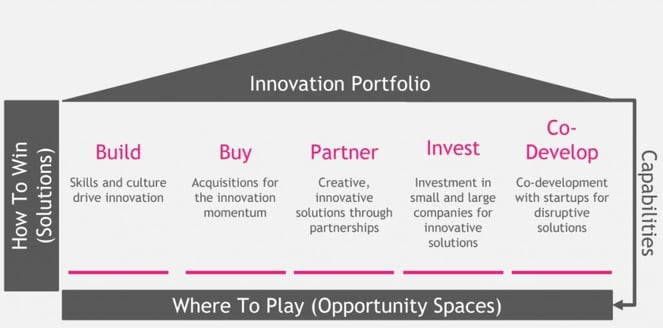When we talk about innovation, we often think of the smart people behind big ideas. But it's not just about having creative thinkers. It's also about building a company environment where everyone feels free to think differently and share new ideas. Many businesses we work with ask the same questions: How can we come up with more ideas? How can we make these ideas come to life faster? It's important to not just focus on the people, but also on creating the right structures that promote a culture of innovation and the right space for innovation to grow.
To enhance innovation efficiency and success, a system needs to be in place that allows a business to scale up without the need to add resources proportionally. In the following, ee have defined six steps that will help you to innovate at scale.
1. Ideators vs. implementors
Are you working “in” your business or “on” your business? Are you still working on ideation or are you actually building an innovation ecosystem supporting the management and the entire company to scale up? When it comes to end-to-end innovation management, we see more elements in the process than effective and efficient ideation.
Here's a piece of advice: Don't be the center of the innovation process. Scaling isn't about removing your individual contribution. Instead, it's about assessing whether your direct involvement is still essential for innovation to happen. If you are still critical to the process, aim to develop a system that can operate independently. This will free you up to focus on other new and exciting ventures.
But how do you find out where you are right now and where to head in the future? You might want to take a step back.
2. Understand the four states of disruption
A good starting point to better understand your industry and the opportunities it offers are the Four States of Disruption. The matrix offers an index measuring an industry’s current level of disruption and susceptibility to future disruption. It also defines where innovation management in certain industries may go in the future and can help you to think of strategic actions to take next.

- Durability. In this state, not much disruption is going on, and we mostly find traditional and mature industries (e.g., tires and rubbers, truck and bus industry).
- Vulnerability. Due to high entry barriers, established companies currently benefit from low competition. Still, consumer expectations are starting to increase, and newcomers are entering the market with new technologies and smarter solutions, putting pressure on the industry to improve efficiency and performance.
- Viability. This field is the playground for new industries that have undergone significant change in the short term. Disruption is a well-known component and no longer occurs as quickly and unexpectedly as before.
- Volatility. The heat is on in this quadrant. Companies are confronted with a high level of disruption and are going to encounter even more changes in the near future. Industries such as consumer tech, hospitality, or investment banking are located here.
For the quadrants, we suggest different impulses to focus on in your innovation management and strategy development.

- Transform the core. Reinvent the legacy business, don’t preserve it. Maintain cost leadership in the core. Run extensive experiments (you have the money and the people). Don’t make big shots yet.
- Scale the new. The speed will pick up quite soon in the future. Address productivity challenges in legacy businesses and get in shape for future innovations (get the right capabilities and people on board).
- Grow the core. Improve what you are good at. Embrace strategies that keep the business in a constant state of innovation.
- Pivot wisely. The only chance to survive in the volatility quadrant is to pivot wisely. A lot of disruption is going on, and changing the current course is the only way to survive. Innovate or die!
3. Create balanced innovation portfolios
Understanding your current position and the direction your industry is moving towards is essential. With that clarity, you can shape your innovation objectives. This encompasses all the projects, initiatives, and stakeholders involved in the innovation journey. Ask yourself: How can I effectively invest in the most promising activities? Which projects align with our goals? Which initiatives should we kick off? What skills and expertise do we need to foster?
In the rapidly evolving global market, innovation is the linchpin of enduring competitiveness. Your organizational strategy should guide the type of innovation pursued, tailored to your customer's needs. The goal? To cultivate a balanced innovation portfolio. This ensures that in the face of market disruptions, the company isn't just reactive but is already systematically generating fresh innovations, all while supporting established revenue generators and phasing out waning ventures.
Overseeing this portfolio means striking a balance between risk and reward. Innovation inherently carries risk, so it's vital that the combined risk of all projects aligns with the company's risk tolerance. Given that many innovative endeavors don't always succeed, it's crucial to have projects that span a broad strategic range for alignment.
Consider three main investment horizons: Protect, Expand, and Transform. Based on your position, tailor your investments to focus on core, adjacent, or transformative projects and initiatives.

A helpful benchmark for a forward-thinking innovation project portfolio is the 70-20-10 rule. This suggests that 70% of a company's resources and budget should be dedicated to preserving and enhancing its core business. Meanwhile, innovations categorized as "new" projects should comprise about 20% of the portfolio. The remaining 10% is ideally reserved for transformative innovations that introduce entirely new offerings to the market.
However, it's worth noting that this ratio isn't one-size-fits-all. It's observed in some companies across certain industries. Your unique circumstances and risk tolerance will determine the ideal allocation for your organization.
4. The table of strategic elements
Once you've gauged the pace and trajectory of change within your company, you can better determine where and how to channel investments to boost innovation.
The Table of Strategic Elements, inspired by Cisco's innovation approach, consolidates crucial information into a single, accessible visual. This table highlights key industry trends, relevant technologies, and emerging business models.

Table of Strategic Elements, based on Cisco’s innovation approach
Not only does the Table of Strategic Elements provide clarity, but it's also a compelling tool to garner support and investments for your initiatives. It captures the trifecta of your innovation efforts: ensuring they are desirable (aligning with market and customer needs), feasible (technologically achievable), and viable (compatible with business goals). You can further prioritize the elements in this table using the 70-20-10 rule: 70% represent familiar trends and core business aspects, 20% are novel to your company, and 10% introduce groundbreaking ideas to the market.
By focusing on balanced innovations that integrate key markets, technologies, and business models, you set clear parameters for your innovation projects, ensuring they align seamlessly with your overarching strategy.
5. The five ways to create new innovation opportunities
By now, it should be clear that innovation is not just about brainstorming or ideation. While activities like ideation challenges can be part of the journey, they're just a fraction of the bigger landscape. Innovation can also encompass collaboration with external partners, startups, or even acquiring new skills and capabilities from another company. Once you've identified your opportunity spaces (what we term as "Where to play?"), there are five strategies to guide you in developing both innovative and game-changing solutions, which we refer to as "How to win?".

- Build refers to the ability to drive innovation from the inside of a business. This could work out through internal innovation challenges, innovation hubs, or centers.
- Buy basically means to bring innovation inside and gain innovative power in relevant verticals by the acquisition of other leading innovators and their key talent.
- Partner is about engaging with other technology and service companies to bring innovative solutions to life.
- Invest is about putting funds into companies with technologies that might be of benefit to the industry’s or your own growth and that might also evolve into partners in the near future.
- Co-develop means prototyping disruptive solutions together with startups or within the scope of academia or internships. In return, the startups or scientific institutions get access to market knowledge, mentoring, and corporate networks.
6. Proper automation will bring innovation to the next level
Innovation is an ongoing process rather than a final destination. But as organizations grow and the pace of change accelerates, manual processes and traditional methodologies can become cumbersome, slowing down the innovation momentum. Here's where the magic of automation in innovation steps in.
- Enhanced decision-making: Automation, through tools like machine learning and text analytics, allows for swift and accurate analysis. Instead of manually sifting through vast databases, articles, academic papers, or patent filings, automation can present you with distilled insights in a fraction of the time. The result? Decisions are better informed and more timely.
- Spotting weak signals and trends: The business environment is rife with weak signals, early indicators of bigger shifts, or trends that might soon take center stage. Automation helps monitor these signs continuously, ensuring you're never caught off-guard.
- Leveraging internal expertise: One of the most significant advantages of automation is its ability to scan the breadth and depth of your organization to identify internal experts. Whether you need skills for scouting, assessing technologies, or monitoring projects, automation ensures that the right talent doesn't remain hidden.
- Building a comprehensive knowledge base: Imagine a centralized repository where all insights—whether about subject matter experts, the latest trends, emerging technologies, or active startups—are stored, updated, and easily retrievable. Automation can make this vision a reality, ensuring that the collective knowledge of the company is always at your fingertips.
Also see: Features to Scale Innovation for Sustainable Business Growth
Now, while the concept of automation might seem daunting to some, solutions like those provided by ITONICS make the transition seamless. The ITONICS Innovation OS is an end-to-end innovation management solution designed to systemize all activities from strategy to execution, at scale.
Our software solution is designed to integrate with your existing processes, enhancing your capability to innovate without adding complexity. It provides a central platform for everything innovation, from environmental scanning, foresight, ideation, innovation portfolio management to strategic planning.
With ITONICS, you're not just adopting a tool but partnering with innovation experts who understand the challenges and intricacies of scaling in today's business environment.
You want to learn more about the features and functionalities of the ITONICS Innovation OS to scale your innovation activities? Get a free demo today!









